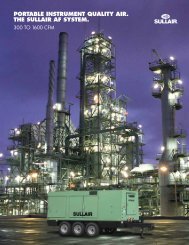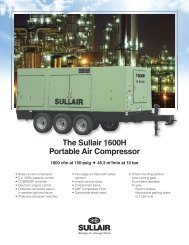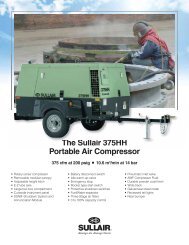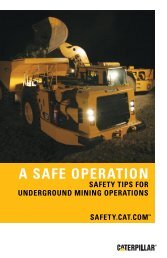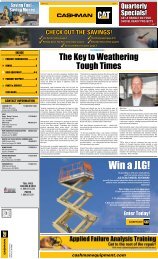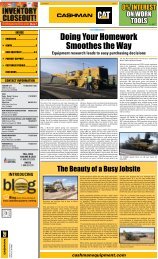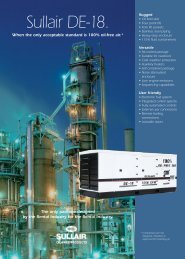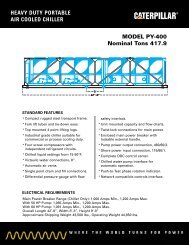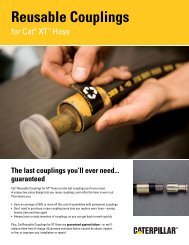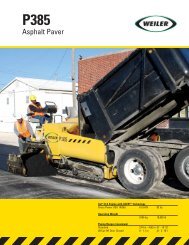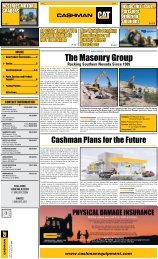Hydraulic System Management Guide
Hydraulic System Management Guide
Hydraulic System Management Guide
- No tags were found...
You also want an ePaper? Increase the reach of your titles
YUMPU automatically turns print PDFs into web optimized ePapers that Google loves.
Elements of hydraulicsystems managementPreventionMany hydraulic system problems can beprevented with attention to the system’snumber-one enemy: fluid contamination.By learning to control contamination, youcan help maintain system efficiency,extend component life and correctproblems before they lead to costlyrepairs and unscheduled downtime.Detection/Cleanup<strong>Hydraulic</strong> systems are closed systems,which means much of what you need toknow is happening internally. To detectwear and other problems that can occurinside the system, we recommend regularuse of our S·O·S SM Fluid Analysis Services.One of these services, Particle Counting,is especially important for hydraulics. Itidentifies excessive contamination levelsthat can be brought under control throughhigh-efficiency filtration, “kidney looping”and other means.InspectionDaily hydraulic system inspectionsperformed by you and your operators cancatch leaks and other small problemsbefore they result in unscheduleddowntime. Efficiency loss is not easilydetected and silently robs your machineof performance. That’s why we alsorecommend technical inspectionsperformed by our trained technicians.These periodic inspections includechecks of system pressures, cycletimes and more—which can identifyproblems and help us recommendcorrective actions.
PreventionKnow the effects of contaminationFluid contamination damages a hydraulic system in two ways.First, it reduces system efficiency. Machine productivity andefficient hydraulics go hand in hand. If a hydraulic system isn’tperforming at peak efficiency, it’s robbing the machine ofperformance. Efficiency losses usually occur slowly and canreach 16 percent to 20 percent before the operator detects aloss in performance. These “invisible” efficiency losses also canincrease fuel consumption.Contamination also accelerates component wear—75 percentto 85 percent of hydraulic pump, motor, cylinder and valvefailures can be traced to contamination. Due to the extremelysmall clearances in today’s hydraulic systems, even particlesyou cannot see can damage pumps, motors, cylinders andvalves in the form of abrasive, adhesive and fatigue wear.Abrasive wearAbrasive particles scrape metal fromhydraulic components. Wear metal iscreated, multiplies and travels to other partsof the system to do more damage.Fatigue wearRepeated high-pressure stress loads causemetal to chip or break from components andcontaminate the hydraulic system.Cat ® <strong>Hydraulic</strong><strong>System</strong> ClearancesVisible to the eyeHuman hairMICRONS5 30 40 80Typical metal-to-metal clearances in Cat ® hydraulic systems are5-30 microns (one micron is one millionth of a meter). Therefore,even particles too small to see can do big damage.Adhesive wear (Silting)Small particles build up on metal surfacesand clog the flow of fluids. The result isjamming and sticking of valves and reducedsystem efficiency.5
PreventionControl contamination during housekeepingIf you have a service shop, housekeeping is the best place to initiate contamination control. Each technicianneeds to understand the importance of contamination control and practice it daily. Here are some tips:Keep floors and workareas cleanSweeping floors daily and maintaininguncluttered work benches with surfacesthat won’t mar parts or add contaminantsare good ways to jump-start contaminationcontrol efforts.Put someone in chargeMaking someone responsible andaccountable for results will help ensurecontamination control becomes anongoing effort.Manage spills correctlyOil spills should be cleaned up promptlyand properly. Absorbent pads, mops andscrubbers are recommended overgranular methods that tend to pollute theair with contaminants.Protect work “in progress”When possible and at the end ofeach shift, make sure in-processrepairs are protected from airbornecontaminants. Ask us about otherrepair processes that can beimplemented to control contamination.7
PreventionControl contamination during oil andfilter changes and oil storageSelect the right oilCat <strong>Hydraulic</strong> Oil contains the neededadditives, like oxidation and foam inhibitors,to help prevent contamination. It also has morethan twice as much zinc as standard industrialoils to provide maximum protection to pumps,motors, cylinders and valves. Be familiar withthe additives in your oil, and don’t compromisequality to save a small amount of money.Change oil regularly and always filter oilstored in bulkCaterpillar has extended the oil changeinterval for hydraulic systems to 4,000 hours,providing certain conditions for monitoring theoil are met. We also recommend changing oilwhen it’s warm and agitated, and alwaysfiltering new oil from barrels or other bulksystems before installation.Use tight-fitting barrel coversTight-fitting covers, such as our 1U6156, canhelp prevent dirt, water, airborne particles andother contaminants from entering oil barrels.It’s also wise to store barrels inside.Control contaminationduring hose assemblyPrecautions you take when assembling and storing hosescan go a long way in minimizing fluid contamination.8
PreventionBesides maintaining a clean facility, paying attention to the hydraulic oil is important.The oil you select and how you store and transfer it all have an impact oncontamination and component life. Filter and fluid changes also present contaminationcontrol opportunities. Here are a few tips:Change filters regularlyand carefully<strong>Hydraulic</strong> filters should be changed at leastevery 500 hours. It’s also important to keepnew filters and other parts packaged untilthey’re ready to install and to remove oldfilters carefully.Use quality filters betweensystem invasionsUsing inadequate filters can compromiseperformance. To maintain the highest levels ofcleanliness and performance, we recommendinstalling genuine Cat Fluid Filters.Use High Efficiency Filters aftermaintenance and serviceContaminants invade the hydraulic system anytime it’s open for maintenance or repair. Werecommend Cat High Efficiency Filters at 250service meter hours following any systeminvasion. Be sure to change High EfficiencyFilters before 250 hours if the bypass indicatorgoes on.Clean hoses properly during assemblyThe cutting and assembly of hoses introduce many contaminants that need to be removedbefore installation. We recommend use of the Cat Hose Cleaner Group, which fires a foamprojectile through hoses, tubes and couplings. This air-powered tool takes only seconds tostrip out metal and rubber contaminants traditional cleaning methods leave behind.Protect stored hose and assembliesBulk hose in storage and assemblies that have been properly cleaned should be protectedfrom airborne contaminants. Installation of caps and plugs is a low-cost means of deliveringthis protection.9
PreventionControlcontaminationduring generalmaintenanceEarlier we discussed the importance offollowing recommended oil and filterchange intervals. A few other preventiontips include:Perform daily inspectionsWhen performing the daily inspections,check for leaks and promptly fix any youfind. Look especially for worn cylinderwiper seals and pitted rods that may begiving dirt and other contaminants a freepass into the system.Keep hydraulic tanks filledAlways keep the hydraulic tank between“Full” and “Add.” Insufficient fluid levelsare the leading cause of pump cavitation,leading to pump failure and contaminationof the entire system. Low fluid levels canalso result in high oil temperatures,causing oil to degrade.Maintain valvesMaintain oil cooler and relief valvesproperly. Relief valve settings should beadjusted only by our trained technicians.If a pressure loss is detected, it’simportant to find its source and repair it.Replace worn fan beltsInspect fan belts, radiators and oilcoolers regularly. Maintaining fan speedand cleaning debris from radiators andoil coolers will help keep the systemoperating at acceptable temperatures.10
PreventionControl contamination duringequipment operationA variety of contaminants can be introduced into your hydraulic systemon the job site. Here are a few ways to guard against contamination:Monitor hydraulic system temperaturesExcessive heat in hydraulic systems thins the oil, increases fluid oxidation, bakes sealsand blisters hoses. It is important to monitor system temperatures and, if equipped, watchtemperature gauges and sensor lights.Use rod protectorsIn extremely dry applications and others where banked rock, corrosive material and debrisare common, we recommend protective covers for the exposed portions of hydraulic cylinderrods. Ask us for details.Use care when changing work toolsWith today’s machines, operators frequently change work tools that are hydraulically driven.If not maintained, these tools can contaminate each machine they’re attached to. Alwaysinspect quick couplers and wipe off dirt from flush-face disconnects before coupling. Protectnipples and couplers with caps and plugs.Listen to your operatorsAn often-overlooked opportunity for contamination control is listening to your operators. Dayin and day out, these individuals live with your machines and can alert you to excessive drift,noises and other signs of possible contamination.
Detection/CleanupKnow what is happeninginside your hydraulic systemsHelping to prevent contamination is important, but you also must know what isoccurring inside your hydraulic systems. Regular use of our S·O·S Services is the bestway to detect component wear and contamination so you can head off problems early.Take samples regularlyTaking hydraulic oil samples regularly—every 500 hours—is critical because itallows for accurate interpretation. When samples are taken regularly, a baseline isestablished so trends can emerge. We need this information to make proper servicerecommendations. How you take a sample is also important. For more information, askus to see video PEVN5514 (VHS tape) or AERV5514 (CD), both entitled “S·O·S ServicesOil Sampling Techniques.”The cleaner the system, the better!Caterpillar recommends a cleanliness target for optimizingcomponent life in Cat hydraulic systems of ISO 18/15 or cleaner.Understand our S·O·S SM ServicesS·O·S Services for hydraulic systems is composed of fourcomplementary tests:• Component Wear Rate Analysis evaluates the wear takingplace inside the lubricated compartment.• Oil Condition Analysis determines if the oil has degraded.• Oil Contamination Tests determine if anything harmful hasentered the oil.• Oil Identification confirms use of the correct oil.S·O·S interpreters use these tests to evaluate hydraulic systemhealth and, if needed, recommend maintenance.12
InspectionFollow theserecommended hydraulicsystem service intervals10-hour or daily inspection• Check hydraulic fluid level• Check hydraulic cylinders and pumpsfor leaks• Check hoses, lines and hydraulic tankarea for leaks or damageCall our servicedepartment for moreinformation on Custom<strong>Hydraulic</strong> Service andto inquire about otherhydraulic systemmaintenance programsthat may be available.250-hour or monthly inspection• Perform 10-hour preventivemaintenance checks• Check hydraulic oil coolerfor leaks or plugging• Check all hydraulic lines for damaged,missing or loose connections500-hour or quarterly inspection• Perform 10- and 250-hour preventivemaintenance checks• Perform S·O·S Services of hydraulic oil• Change hydraulic filter• Check hydraulic pumps and mountingsfor loose or missing hardware1,000-hour or six-month inspection• Perform 10-, 250- and 500-hour preventivemaintenance checks• Check pump weep holes for leaks2,000-hour or annual inspection• Perform 10-, 250-, 500- and 1,000-hourpreventive maintenance checks• Check hydraulic system pressure• Check hydraulic system cycle times anddrift ratesThe final element in hydraulic system management involves inspecting and“listening to” your equipment. You can help maintain system performance andcatch problems early by:• Following the inspection and maintenance schedule shown on this page• Enrolling hydraulics-intensive machines in our Custom <strong>Hydraulic</strong> Service Program• Paying attention to the repair indicators listed on page 15Custom <strong>Hydraulic</strong> Service (CHS)Once a year or every 2,000 hours, we recommend having your hydraulic systemsinspected by our trained service professionals. During these CHS inspections we:• Conduct a detailed visual walkaround inspection of the hydraulics, enginecompartment, cab, power train and ground engaging tools• Drift test all hydraulic cylinders• Perform complete checks of cycle times and system pressures• Stall test the hydraulic system• Take a sample of the hydraulic oil and perform S·O·S ServicesAfter interpreting the inspection and fluid analysis results, we’ll meet with you todeliver a complete report. If service is necessary, we’ll also provide a quote. Weoffer a variety of repair options and can help you decide on the one best for you.
InspectionPay attention to repair indicators!Repair Indicators Possible Causes Cat Dealer Service OptionsLeaksExcessive cylinder driftSlow cycle timesNoisy operation<strong>System</strong> overheatingLoose cylinder jointsBlisters or abrasions in hoseExcessive hose movementS·O·S ServicesHigh service meter hours<strong>System</strong> pressure too highScored or bent cylinder rodFailed or incorrect sealsImproperly torqued hose connectionWorn or damaged hoses, tubes and fittingsMissing guardsValve adjustment neededScored cylinderFailed seal or sealsScored valveContaminated oilEngine performanceFaulty valveLow fluid levelWorn system componentsContaminated oilEngine performanceLow fluid levelRestriction in systemAerationWorn system componentsFaulty relief valveFaulty oil coolerLow fluid levelPlugged filterWorn system componentsFaulty relief valveWrong viscosity or contaminated oilRestriction in systemPoor operator habitsWorn rod or cylinder eye/trunnionPoor lubricationImproper preventive maintenance schedulePinhole leaks in liner materialPoor hose routingExternal damage<strong>System</strong> overheatingImproper clamping or routing of hoseAeration/cavitationHigh levels of wear elements, dirt andother contaminants in oil will acceleratecomponent wear and erode system efficiencyTalk with us to determine what high-hourservice is appropriate for your systemsHose serviceThorough visual machine inspectionMaintenance and diagnostic servicesS·O·S ServicesCustom <strong>Hydraulic</strong> ServiceIdentification and measurementDiagnostic servicesS·O·S ServicesCustom <strong>Hydraulic</strong> ServiceMachine measurements compared to specsDiagnostic servicesS·O·S ServicesCustom <strong>Hydraulic</strong> ServiceThorough visual machine inspectionS·O·S ServicesCustom <strong>Hydraulic</strong> ServiceThorough visual machine inspectionMaintenance and diagnostic servicesS·O·S ServicesCustom <strong>Hydraulic</strong> ServiceComponent inspection/repairCustom <strong>Hydraulic</strong> ServiceThorough visual machine inspectionHose serviceCustom <strong>Hydraulic</strong> ServiceHose servicePreventive maintenance schedule consultationCustom <strong>Hydraulic</strong> ServiceConsult with dealerCustom <strong>Hydraulic</strong> Service15
Comprehensive serviceand supportMore and more of your operating costs are tied to hydraulic systems.We are committed to helping you lower those costs—as well asmaximize efficiency, productivity and machine availability—throughongoing attention to contamination control and the other systemmanagement elements.Ask us how we can incorporate a hydraulic system managementprogram into a Customer Support Agreement to achieve these results.For more information about our hydraulic products and services, callus today or visit the Caterpillar website at www.cat.com.CAT ® DEALERS DEFINE WORLD-CLASS PRODUCT SUPPORT.We offer you the right parts and servicesolutions, when and where you need them.The Cat Dealer network of highly trainedexperts keeps your entire fleet up and runningto maximize your equipment investment.PEGP6028-05www.cat.com© 2007 Caterpillar • All Rights Reserved • Printed in USACAT, CATERPILLAR, their respective logos, “Caterpillar Yellow” and the POWER EDGE trade dress, as well ascorporate and product identity used herein, are trademarks of Caterpillar and may not be used without permission.



